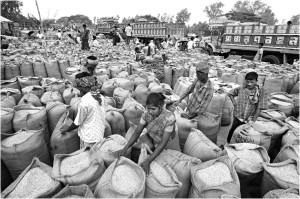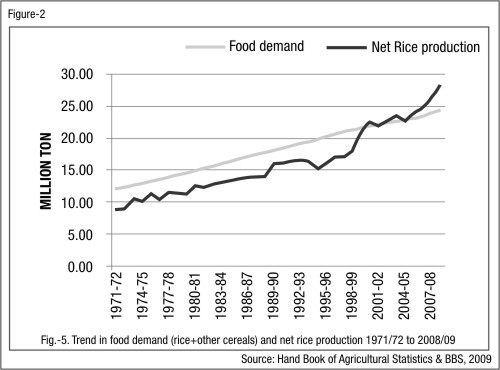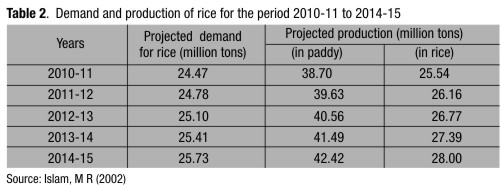
Food autarky: Rice dilemma
Md. Ariful Islam, Dr. Jiban Krishna Biswas and Dr. Md. Khairul Bashar
 |
Photo: Shafiq Islam/Driknews |
BANGLADESH is predominantly an agriculture based country with more than 146.1 million people living on 14.84 million hectares of land. The population is expected to increase, by the year 2050, around 200 million. Half of this huge population will be urban dwellers (BBS, 2009). As staple dietary item per capita rice consumption is about 166 kg/year (BBS, 2007). It alone provides 76% of calorie and 66% of total protein requirement of daily food intake (Bhuiyan et al, 2002). It also contributes around 11% of total agricultural GDP and employs about 43.6% of total labor forces (BBS, 2009). Rice covers about 82% of the total cropped area in Bangladesh (Fig.1) (BBS, 2009).
Sub tropical climate constitutes an excellent habitat of rice in Bangladesh. However, there are different rice ecosystems namely: upland (direct-seeded pre-monsoon Aus), irrigated (mainly, dry-season boro), rainfed lowland (mainly monsoon-season transplanted Aman (T. Aman), 0-50 cm water depth), medium-deep stagnant water (50-100cm), deepwater (>100cm), tidal saline and tidal non-saline. The rice area planted to Aus is 9%, to Aman (mainly T. Aman) is 48% and to Boro is 43% of the total rice area of Bangladesh (BBS, 2009).

Rice and wheat are the two main food grains of Bangladesh. Rice alone constitutes the lion share (96 %) of the total food grain produced in the country (BER, 2009). Though wheat ranks second but covering only 3% of the total cropped area (BBS, 2009). The country since its independence had to depend on imported food grain to satisfy the extra demand of the ever-increasing population.
Because of overwhelming importance of the national economy, rice is considered as a politically strategic commodity in Bangladesh. Since the independence, rice production program has been getting priority considerations by the governments, politicians, researchers and other development partners. Accordingly, the country has made a dramatic achievement in rice production during the last four decades. In 2002, the country has claimed to be not only self-sufficient but surplus too in rice production (Table 1).
This has been made possible through the cultivation of modern varieties (MVs) of rice along with the component technologies mostly developed by Bangladesh Rice Research Institute (BRRI).
The Green Revolution initiated its journey in the early sixties with the concept of introduction and rapid diffusion of modern varieties (MV) of food grains like rice and wheat. The assumption was that it would have direct impact on the problem of malnutrition, hunger and poverty of the rural people. In Bangladesh, the cultivation of MVs rice began in 1967 and 1970, during Boro and T. Aman, respectively with the introduction of seeds of IR8 and IR20 (later on known as Irrisail) from the Philippines developed by the International Rice Research Institute (IRRI). During sixties, two other varieties, Purbachi (Taiwan origin) and Pajam (Malayasian origin) were also introduced in Bangladesh.
 |
Photo: Munem wasif/DrikNews |
BRRI was established in October, 1970 with the mandate to conduct research on all aspects of rice in order to develop MV rice with high yield potential for different ecosystems existing in various land categories; develop component technologies for improved cropping systems, and to transfer rice technologies through training, workshops, seminar and publications (BRRI, 1984). Since its establishment, BRRI has developed 57 MVs including 4 hybrid for cultivating in three different cropping seasons. These are being grown with good fit into the rice-based cropping systems. To-date, BRRI has developed and recommended 39 location specific improved rice-based cropping patterns for different land types. Some other MVs like Iratom24, Binasail, BINA dhan7, and BINA dhan8 have been released by Bangladesh Institute of Nuclear Agriculture (BINA). Bangladesh Agricultural University (BAU) developed a variety BAU63. Bangabandhu Sheikh Mujibur Rahman Agriculture University (BSMRAU) has recently developed a short duration T. Aman variety called BU dhan 1. Some exotic varieties like Swarna and the like came across the border through informal farmer to farmer exchange of seeds. In fact, the country experienced a major breakthrough in rice cultivation through the release of BR3 (Biplob) in 1973.
Trend in land use pattern
Land is the key but scarce natural resource in Bangladesh. The total rice area was 10.31 million hectare in 1980 and 10.58 million hectare in 2007 which is about 2.64% higher than the base year 1980. During the 30 years, total rice area remained almost static for a number of years with little ups and downs. On the other hand, no significant change was observed in total cropped area (TCA) during the recent years. The TCA of 13.88 million hectare (mha) for the year 2007 was 5.47% more, resulted from the increased cropping intensity compared to those of the base year 1981. Net sown area (NSA) remains static at around 8.15 mha during the last two decades. There has been a great increase in the cropping intensity and was found to increase from 153.74% in 1981 to 179% in 2008.
Trend in rice area by season and variety
By eighties, the MV rice area coverage was around 32% and has attained to 261% in 2006/07. In contrast the area under LV (low yielding varieties) decreased significantly. Through the total rice area did not change much during the four decades; there had been a major shift in rice cultivation. The area under MVs of Boro rice was 0.32 mha in 1971 to 4.11 mha in 2007.
This increase was possible at the expense of the low lying, deepwater Aman rice and upland Aus rice areas. Transplanted Aus (T. Aus) area under MVs was remained static at around 0.41 mha while the coverage MVs of T.Aman reached 3.34 mha. Over the period, the areas under local Aus has declined from 2.95 to 0.43 mha, and T.Aman from 3.38 to 1.60 mha and Deep water Aman from 1.77 to 0.48 mha. Local Boro area had also exhibited decreasing trend, from 0.54 mha in 1971 to 0.14 mha in 2007. However the very recent trend is almost static.

Trend in rice production by season and variety
Total area under MVs was increased from 2.25% to 74% during the last three and half decades (FPMU, 2009), which contributed to boosting total rice production from 9.77 mmt to 31.32 mmt in 2008/09 at exponential growth rate of 2.78% per annum (BBS, 2009). Overall MVs rice production increased from 1.79 mmt to 23.57 mmt, whereas the production of LVs was 7.98 mmt to 3.75 mmt (BBS, 2007).
Rice production under HYV Boro and T. Aman showed increastig trends and reached from 0.97 mmt to 17.81 mmt and 0.70 mmt to 9.08 mmt, respectively during 1971/72 to 2008/09, while the production under MV Aus remained almost static in 2004/05 period. But Aus is also in its increasing trnd for last four years. The major share in total rice production came from MV Boro (57%) and MV T.
Aman constituted (29%) of the total rice production. Rice production
Trend in net food demand and rice production
The population of Bangladesh in 1971 was 71.1 million, which over the years increased to 146.1million in 2008 (BBS, 2009). During this period, the net food grain demand was increased from 12.02 million metric tons (Mmt) to 24.22 Mmt which is double of the year 1971 (Fig.2). The rice production also increased steadily along with net food demand (Rice+Wheat) and reached 28.18 Mmt in 2008. It means the country has attained marginally self- sufficiency in food by rice alone.
Future projection of rice
production:
Projected demand (in terms of rice) and production (both in terms of paddy and rice) from 2010-11up to 2014-15 are shown in Table 2. The projected demand for rice is based on estimated population, income and income elasticities calculated for the said period. The aggregate demand for rice will be around 24.47 million tons in 2010-11and 25.73 million tons in 2014-15. On the other hand, projected production for the corresponding years are shown in the table both in terms of paddy and rice.
Intervention needed for increasing productivity
Through promoting rice farmers' awareness and practice to use clean, healthy and quality seeds, rice yield could be increased substantially. The participatory research with rice farmers in Gazipur and Chuadanga indicated that, farm level yield of MV rice could be increased by 0.42 and 0.52 t/ha in T.Aman and Boro season, respectively (BRRI, Agril. Economics Division). Similarly, farm level yield could be increased by 8-10% through using the certified seed as observed by BRRI GRS division. These imply that, increase in the level of yield just through using improved technology would eventually help farmers enhance productivity which inturn would cause to decrease per unit cost of production.
Results from field experiments of BRRI Agronomy division clearly demonstrated that planting of BRRI dhan28 in Boro season by 25 January gave the optimum yield under normal agro-climatic condition. Planting of this promising and popular variety after 4th week of January would cause severe yield deterioration. Therefore, MV Boro growing farmers should be encouraged for planting the aforesaid varieties within the optimum time in order to achieve higher yield and thus avoid severe yield loss.

Previous research and field demonstrations have very confidently indicated that, use of herbicide instead of manual weeding in controlling weeds in rice field would be more judicious and highly cost saving. Results of earlier studies (BRRI, 2004) shown that, on average Tk. 2200-Tk. 2400 per hectare could be saved through using herbicide instead of manual weeding.
The level of yield achieved by the rice farmers under stress prone salinity affected areas was observed much lower in Boro season due to use of non suitable varieties (i.e. BRRI dhan28, 29 etc.). It was highly noticed that, BRRI dhan47 can out yield any other variety under salinity affected southwestern vast areas of the country. Therefore, rapid dissemination and adoption of the saline tolerant rice technology (i.e. BRRI dhan47) would render substantial yield gain not only at the micro level, but also at the broader level and would help up lifting rice productivity. Recently, BRRI has released two submergence tolerance rice varieties (BRRI dhan51 and BRRI dhan52) for flash flood submergence prone areas for sustaining rice production.
Given the nearly total dependence on rice for food security, Bangladesh faces many challenges such as, how can we increase rice production in the face of shrinking cropped land (every year at the rate of 1%), increasing population and global climate change. How much rice we need to feed the people? Can we produce enough rice when the country's population grows to 170 million in 2020? Currently rice is planted to about 10.58 million ha producing 31.32 million tons of rice. In the face of ensuing climate change, higher global temperatures, declining water resources, limited supply of costlier fertilizers and loss of cropped land, sustaining yield will remain a big challenge. Apart from narrowing yield gap, further yield increase will also be necessary. It would be essential to evolve varieties tolerant to high temperature, particularly to high night time temperatures (Peng et al., 2004), better water use efficiency, improved drought tolerance, higher nutrient use efficiency, a greater degree of tolerance to disease and pests, and to reduce post harvest losses.
For achieving the goal, BRRI and the other organization (related to rice research) prioritized the following research activities:
i) Develop more yield potential MV and hybrid rice varieties
ii) Develop adverse climate (such as cold, drought, submergence, salinity and tidal submerge) tolerant rice varieties/technologies.
iii) Develop high nutritious rice (such as: VitA, Iron and Zinc).
iv) Develop pest and disease tolerant varieties.
v) Develop yield increasing rice technologies and disseminate at farmers' level.
vi) Develop irrigation saving technologies, increase irrigation coverage for rice and reduce irrigation cost.
vii) Develop low cost rice producing technologies such as LCC, USG, Drum seeder, AWD and disseminate at farmer's level.
viii) Improve agriculture and farmers' livelihood through crop diversification and suitable crop rotation.
ix) Develop rice varieties for different agro-ecological situations and environments.
x) Preserve and utilize local and international rice germplasm.
xi) Provide sufficient quantity of Breeder Seed to the GO-NGO-PS seed producing organization.
What ever the organizations related to rice research have achieved in rice agriculture is quite shaky. We are always, having hard time to cope with the population increase. The achievement has little to do with the food self sufficiency as we are far away to provide our people with balanced diet. Therefore, rice had to release some of its coverage to other crops also. The proper allocation of land for rice cultivation would help to reduce the yield gap in rice culture also. So the total production will not be affected. However, the policy makers economists and crop experts should thing accordingly.
Dr. Md. Khairul Bashar is Director (Research), Dr. Jiban Krishna Biswas is Chief Scientific Officer and Md. Ariful Islam is Scientific Officer, BRRI.